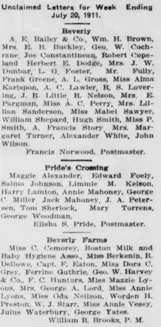
Newspapers in the United States during the 18th, 19th, and early 20th centuries published columns listing letters and other items that were not claimed at the local post office. These columns often carried the heading "Unclaimed Letters" or "Letters Waiting at the Post Office" or "Unclaimed Mail."
There was a process to be followed when mail was left unclaimed at the local post office. According to the United States Official Postal Guide[1], 1893 edition, unclaimed mail should be advertised "conspicuously" in the post office lobby or local newspaper and "Postmasters are required to collect one cent postage-due upon all letters advertised, whether by posting or otherwise, which are subsequently delivered."
The maximum amount of time items could be held was 90 days. Items remaining unclaimed after advertising were then sent on to the Dead Letter Office of the United States Postal Service in Washington, D.C.
The procedures outlined in the United States Official Postal Guide also specified that "names should be separated alphabetically and the names of ladies and gentlemen in separate lists." Some unclaimed letters advertisements followed this rule while others did not. According to postal history of the United States Post Office, "ladies delivery windows" were established at Post Offices in more than 75 cities coast to coast[2]. In large cities, women did not need to encounter the "rougher element" when retrieving their mail. And, "Women were able to have mail addressed to them in care of the ladies window, allowing them to shield their addresses from correspondents."
Research your ancestors on MyHeritage
Genealogical research value of Unclaimed letters columnsGenealogical research value of Unclaimed letters columns

For researchers, the information listed in these newspaper columns offer a wealth of facts and clues about an ancestor's life. Specifically, an ancestor can be placed at a specific location and within a specific timeframe. This is important for time periods between census enumeration dates.
- Name information: lists were sorted alphabetically by last name (and sometimes separated into lists for women, men, and "foreign." Review the entire list of names to get clues on possible relatives.
- Movement and migration: trace an ancestor's movement from one location to another using unclaimed letter information. Often, before establishing a household with a fixed address, letters were sent to "general delivery" to the nearest post office.
- Occupations and social status: look for prefixes and suffixes added to names such as "Dr." or "Mrs." or "Miss."
Locating Unclaimed letters columnsLocating Unclaimed letters columns
While a post office was required to post a list of unclaimed letters at the post office building, most postmasters opted to place an advertisement in the local newspaper. Since the United States Official Postal Guide specific that money could not be expended on these ads, they were often carried as a courtesy by the local newspaper in an ongoing regular column under the heading "Unclaimed Letters," "Unclaimed Mail," or "Letters Waiting at the Post Office." Often, these columns appeared along with the legal notices and personals section of the newspaper.
Historical newspapers are available both online and for in-person research at archives, libraries, and repositories. Use the search terms "unclaimed letters," "unclaimed mail," or "letters waiting."
See alsoSee also
Explore more about Unclaimed LettersExplore more about Unclaimed Letters
- MyHeritage Newspaper collection
- OldNews by MyHeritage
- United States Official Postal Guide, 1893 edition
- United States Postal Service Ladies Delivery Windows
- United States Postal Service, Mail Recovery Center ("Dead Letter Office")
- United States Postal Service, Postal History, Post Offices and facilities: Ladies Delivery Windows
References
- ↑ United States Official Postal Guide. United States, U.S. Government Printing Office, 1893.
- ↑ United States Government. (n.d.). Ladies Delivery Windows. United States Postal Service - Postal History, accessed 31 March 2024

